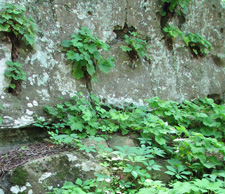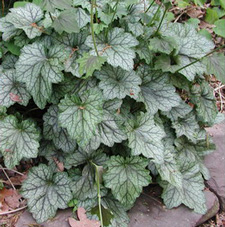Resource Library
Plant of the Week: Alumroot
The University of Arkansas System Division of Agriculture does not promote, support or recommend plants featured in "Plant of the Week." Please consult your local Extension office for plants suitable for your region.
Plant of the Week
Alumroot
Latin: Heuchera Americana

Plants grow in the most improbable places. I've seen it before but am always amazed when I see alumroot (Heuchera americana) growing out of seemingly dry cracks in a massive boulder. But if you look around on the ground beneath these plants you won't find it. It seemingly likes its perch in the air on the rocks.
Alumroot, also called wild geranium by some, is a widely distributed herbaceous perennial wildflower found in woodlands throughout the eastern states. It's a member of the Saxifrage family, which, fittingly enough, translates from Latin as "rock breaking."
Plants are semi-evergreen mounds growing 6 to 18 inches tall, depending on how hard the rock is they are trying to break. Plants develop long, stout rhizomes that slowly creep down a crevice in the rock. The leaves are round-lobed and resemble those of the common geranium.
In late spring or early summer, alumroot sends up tall, open spikes adorned with small, greenish-white flowers. The flowers are not especially attractive and shouldn't be confused with those of its showier cousin coralbells (H. sanguinea).
Alumroot gets its name from the astringency of the fleshy root. It has been used in medicines to treat external sores and wounds and internally for various gastric ailments. It has also had a place as a treatment to rub on the gums of teething babies. Its astringency has also made it useful as an alum substitute in fixing natural dyes.

Alumroot doesn't have to grow on a rock. In fact, if given good soil, it grows larger and healthier than in a tight rock crevice. Its rocky perch is dictated by its germination requirements.
It produces copious amounts of tiny seeds but they're not well suited for coping with leaf litter of the forest floor. If a little water is retained in a small crevice the seeds germinate quickly. Once germination has occurred, Heuchera seedlings are extremely tough.
I've left them outside in small pots, neglected them without mercy and they never seem to flinch. Almost any other seedling would perish with similar mistreatment.
The green-leafed form of alumroot isn't much grown in gardens as a groundcover, but it could be for they adapt well to dry shade. More common in cultivation are some of the marble-leafed selections such as Dale's Strain. It has beautiful silvery leaves veined with green and rimmed in green. The leaves are richly infused with maroon when they emerge in the spring; in the autumn and winter they take on the look of old pewter cups.
Alumroot is easy to grow in any reasonably good garden soil. I have found this species and Dale's Strain to persist long term in the dry shade of my garden whereas many of the other species that do not use H. americana as part of their parentage tend to fade away in three to five years.
By: Gerald Klingaman, retired
Extension Horticulturist - Ornamentals
Extension News - June 22, 2007
The University of Arkansas System Division of Agriculture does not maintain lists of retail outlets where these plants can be purchased. Please check your local nursery or other retail outlets to ask about the availability of these plants for your growing area.